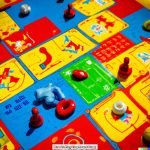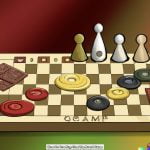Introduction
Clue, a classic board game of murder mystery and detective deduction, is an excellent way to introduce yourself or your children to the world of strategy and logic. Interesting characters, such as Professor Plum, Miss Scarlet and Colonel Mustard, add an element of intrigue while players solve the case. According to Hasbro’s website, Clue is recommended for ages 8 and up; however, it can be adapted for any age group.
The objective of the game is quite simple: uncover who committed the crime (i.e., killed Mr. Boddy), what was the weapon used to commit the crime (i.e., dagger), and which room in his mansion was where it happened. Although determining these facts may seem straight forward at first glance, first-time players will quickly learn that there are different levels of strategy involved with this game – from tallying probability points on a scorecard to choosing which cards to reveal during strategic turns and combatting any “red herrings” thrown around during accusations! Each player must select what cards they want to look at in order to make their accusation correctly. During each player’s turn, they need to identify which room they would like to move into based on their current revealed information and act accordingly by either making an accusation or asking another player if they have any specific cards that can assist you by advancing you closer towards resolving your case (or alibi’ing a suspect or item in your theory). Once you are certain you have collected enough evidence – or deduced who most likely did it – then it’s time for an official Accusation Round where one player puts forth their ideas on who actually committed the crime along with what item was used and which room it happened in! The other players must now decide whether this Accusation Stack is correct or incorrect – no holding back! If successful in solving the case before anyone else does, that one brave soul will become known as The Master Detective!!
Rules of the Game
Objective : The objective of CLUE 2016 is to be the first player to figure out the three parts of the crime: who did it, with what weapon and in which room.
Set Up : To begin playing CLUE 2016, separate all cards into 3 categories before dealing them out evenly among players : Suspect Cards, Weapon Cards and Room Cards. There should be one less card from each category than there are players, so set the extra cards aside without looking at them. These are known as ‘Clue’ cards. Randomly select one card from each pile and place that card face-down in the center of the board. This will be your ‘Crime’ card.
Gameplay : Taking turns clockwise, every player starts their turn by rolling 2 dice and moving around the board corresponding to their roll. As they move across different squares on the board they may draw a ‘Suspicion’ Card; these are essentially questions asking if a certain character was seen in a certain room with a certain weapon and it is always directed towards another player. At this point, if any player knows that answer to that particular question then they must show their suspect/weapon/room card matches up to answer and note that this is your clue for future reference on your sheet provided for every round you play. Hopefully at this point you will have enough information to make an educated guess as to who committed this crime!
Ending The Game: To win Clue 2016, one player must demonstrate that they know all 3 components of who committed the crime (suspect/weapon/room). If another players has evidence that contradicts this then they can challenge your accusation; if it turns out they were right then they win instead of you! If you manage to prove your accusation correct then all revealed cards will be shared amongst everyone else who was playing and everyone takes their remaining game pieces off of board – Congratulations on solving about the mystery in CLUE 2016!
Game Setup
Clue is a classic board game, where players assume the role of detectives in order to solve a mystery. The game first began in 1949 and has been entertaining kids, families, and adults alike for over 70 years! To play this game, you will need: 1 Clue board with six possible weapons (a rope, candlestick, wrench, revolver, lead pipe, or knife), 1 deck of 21 suspect/location cards consisting of 9 suspects and 12 locations (the study, hall, conservatory spa room and more), 6 colored pawns that represent the players’ characters; Colonel Mustard (yellow), Mrs. Peacock (blue), Professor Plum (purple), Mrs. White (white), Mr. Green (green) and Miss Scarlet (red).
Before playing Clue , setup the board by placing each character pieces on their respective starting location indicated by the circular clock-like spaces on the board. Shake up the deck of suspect/location cards and hand out room suspect cards to each player – every player should have 3 cards which can be kept secret from other players. Place any leftover cards back in the box without looking at them. Now it’s time to decide who wants to be designated as first detective by having each person roll a die – highest roller goes first!
Once all players are ready begin playing by rolling a die on your turn which lets you move around specific amount of squares indicated by how many dots are on the dice rolled – your figure must land on an open space or door-way space located between rooms. You may enter any adjacent room through those door spaces that immediately follow this path making sure not to move past them and enter into multiple rooms during one turn. On other turns when you are able too investigate any specific location against two other people who may had previously visited it but only if all three people were together at that location before splitting up moving forward giving room to further investigation which should also help narrow down who’s responsible as well as which item they used – eventually leading turning one of your suspicions into reality leading to an accusation ringed true upon correctly so once initial accusing points out their targets within their accusations if correct all player must reveal their held secret suspect/room cards for verification success if fails accused player takes another turn trying again until correct resolution made officially ending that round
Gameplay
Clue Board Game 2016 is a classic game of deduction and detective work. The aim of the game is to be the first player to discover who committed the murder, where it happened and which weapon was used. In order to do this, each player must use the available clues that come from the cards drawn when it is their turn.
To practice gameplay, it can be helpful to focus on tactics and strategies. Every game starts with players being dealt three cards – all players will know two of them but only one player knows the third. It’s advantageous to look for patterns or set up situations as early on in the game as possible so that you don’t suddenly discover at the end of play that you already had all three pieces of information you needed earlier in the game.
Additionally, it pays to focus on logical deductions and accurate note-taking; keeping an up-to-date record of what other players have seen or ‘rule out’ can be invaluable when trying to complete puzzles quickly. This can also help prevent players from repeating guesses, saving them precious turns {which translates into time}. Lastly, try your best to maintain an open mind; since every player has different cards and various methods for discerning information, pay attention and remain cognizant of all possibilities throughout gameplay!
Strategies
Strategy One: Pay Attention to the Escape Routes. Knowing all of the possible pathways from each room, as well as Secret Passages, gives you the best chance at having a “route-driven” strategy. This means that if your opponents are trying to escape a room with one of your cards while they are in another, it will be easy for you to move around quickly and confront them.
Strategy Two: Make Accusations Early and Often. Suitable accusations can force your opponents to disclose information that is necessary for you to determine who and where the real murderer was. By continually making accusations (even if they are false), you can not only learn useful information, but also frustrate your opponents into revealing further answers.
Strategy Three: Don’t Be Afraid To Take Chances. If a particular situation makes sense or has some probabilistic validity, don’t be afraid to take it. Taking chances—and being wrong—is better than running out of time with an unfinished board. You may work out how likely an answer might be by considering what could happen during your turn: Can I go from one particular room back around the hallway? Do I have any cards which make this move possible or easier? How much time do I have left?
Strategy Four: Don’t Get Caught Up In Your Opponent’s Strategies. While this may seem obvious — and even frustrating when your opponent do things that prevent you from narrowing down possibilities — try not to let it distract you too much. Focus on making solid moves and formulating strategies of your own, instead of obsessing over what others are doing on the board.
Variations
Let’s face it: the standard version of Clue can get a little repetitive, especially for those who play it often. To bring some variety to the game – and possibly open up clues you may have been missing – try out one of these fun variations:
1. Play With Role Cards- This variation gives each player a secret role in addition to their character. Each player has two roles– they are either an innocent or guilty suspect, and they are either a detective or murderer. Players must decide between themselves whether to reveal their assigned role to others or keep it hidden throughout the game.
2. Speed Play- In this variation, the game is played much faster than usual – while the traditional rules still apply, players only need 10 minutes to complete the entire game! To facilitate speed play, make sure everyone is familiar with the steps required for making accusations and verifying evidence cards.
3. Detective’s Notes- To add suspense and intensity to your gameplay, include detective’s note cards when setting up your board. Each time someone makes an accusation that is incorrect, one of these notes will be revealed — containing a special clue about who did it (or didn’t do it) in the end!
4. The Gambler’s Suspicion- For those who are daring enough to chance it all out on one guess, this variation lets you put your money where your mouth is! Before beginning play, each participant must come up with two secret questions they think might be answerable by evidence uncovered during the course of gameplay; at the end of the game, whoever correctly answers both questions wins a “prize” chosen by all other players — usually bragging rights and maybe a small treat or gift card.
Conclusion
CLUE is a timeless classic that should be a staple in any family’s game night routine. Not only does it provide quick entertainment and strategic fun, but it is also an interactive way to socialize and bond with friends and loved ones. The combination of luck and critical thinking makes the game an endlessly intriguing challenge and means that even after a hundred plays you could enjoy greatly different scenarios each time. CLUE’s ability to incorporate people of all ages simultaneously and create cherished memories allows you to make the game your own, no matter where you play it. With its consistent structure, exciting twists, and charming character pieces, CLUE has something memorable to offer everyone at every game night gathering. Not only will each experience be unique but they can also serve as valuable milestones as life continues onward!

I love playing all kinds of games – from classics like Monopoly to modern favourites like Ticket to Ride.
I created this blog as a way to share my love of board games with others, and provide information on the latest releases and news in the industry.





